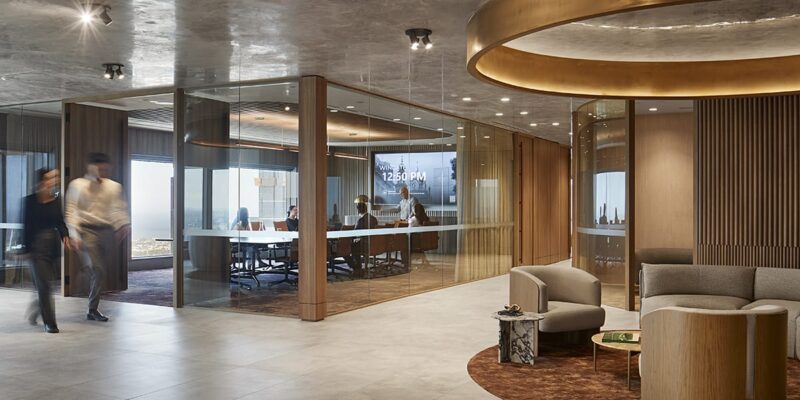
In today’s competitive business landscape, employee satisfaction is crucial for retaining talent, enhancing productivity, and fostering a positive workplace culture. One of the most impactful ways to boost employee satisfaction is through effective workplace interior design. A thoughtfully designed workspace can promote well-being, inspire creativity, and improve collaboration. This article explores how strategic workplace interior design can elevate employee satisfaction and create a more engaging and productive work environment.
Understanding the Importance of Workplace Interior Design
The Impact of Interior Design on Employee Satisfaction
Workplace interior design encompasses the planning, layout, and aesthetics of an office space. It involves creating an environment that meets the functional needs of employees while also appealing to their senses. A well-designed workplace can significantly influence employee morale, motivation, and overall satisfaction.
Key Benefits of Effective Workplace Interior Design
- Improved Well-Being: Thoughtful design promotes mental and physical health.
- Enhanced Productivity: A functional layout can streamline workflows.
- Increased Engagement: Attractive environments foster creativity and collaboration.
- Positive Company Culture: Reflects the organization’s values and mission.
Essential Elements of Workplace Interior Design
1. Flexibility in Design
Adapting to Diverse Needs
Modern workplaces must accommodate various work styles, from collaborative teamwork to focused individual tasks. Flexibility in design allows for a range of spaces that can adapt to the changing needs of employees.
Key Features of Flexible Design
- Modular Furniture: Adjustable and movable furniture that can be reconfigured easily.
- Diverse Workspaces: A mix of open areas, quiet zones, and collaborative spaces.
- Multi-Purpose Rooms: Spaces that can serve different functions, from meetings to social gatherings.
2. Ergonomics and Comfort
Prioritizing Employee Health
Ergonomic design focuses on creating comfortable and supportive work environments that prioritize the health and well-being of employees. This approach can reduce workplace injuries and enhance overall satisfaction.
Ergonomic Design Considerations
- Adjustable Desks: Allow employees to switch between sitting and standing.
- Supportive Seating: Invest in high-quality chairs that promote good posture.
- Optimized Workstations: Arrange equipment to minimize strain and maximize efficiency.
3. Biophilic Design Elements
Bringing Nature Indoors
Biophilic design integrates natural elements into the workplace, promoting well-being and reducing stress. Connecting employees with nature can improve mood, creativity, and productivity.
Examples of Biophilic Design
- Natural Lighting: Maximize the use of daylight with large windows and skylights.
- Indoor Plants: Incorporate greenery to enhance air quality and aesthetics.
- Natural Materials: Use wood, stone, and other organic materials in furniture and décor.
4. Color Psychology
Creating the Right Atmosphere
Colors can significantly affect mood and behavior. Understanding color psychology can help create a workspace that enhances employee satisfaction and productivity.
Color Choices and Their Effects
- Blue: Promotes calmness and focus, ideal for workspaces requiring concentration.
- Green: Represents nature and balance, fostering a sense of tranquility.
- Yellow: Inspires creativity and energy, suitable for collaborative spaces.
5. Technology Integration
Enhancing Connectivity and Efficiency
Incorporating technology into workplace interior design is essential for facilitating communication and improving productivity. Modern offices should integrate advanced tools that support employee collaboration and efficiency.
Key Technological Features
- Smart Meeting Rooms: Equip rooms with video conferencing tools and interactive displays.
- Collaboration Tools: Use project management software and digital whiteboards to enhance teamwork.
- High-Speed Internet: Ensure reliable connectivity throughout the office.
Creating a Positive Work Culture through Design
1. Employee-Centric Spaces
Focusing on the Workforce
Designing with employees in mind is crucial for creating a positive work environment. Spaces should cater to their needs, preferences, and well-being.
Features of Employee-Centric Design
- Breakout Areas: Create informal spaces for relaxation and socialization.
- Wellness Rooms: Designate areas for meditation, yoga, or quiet reflection.
- Diverse Work Areas: Offer a mix of collaborative and individual workspaces to accommodate different work styles.
2. Reflecting Company Values
Aligning Design with Organizational Culture
The workplace should reflect the company’s culture and values. Thoughtful design choices can communicate the organization’s identity and foster a sense of belonging among employees.
Strategies for Cultural Alignment
- Branding Elements: Incorporate company colors, logos, and artwork that represent the brand.
- Collaborative Spaces: Design areas that promote teamwork, aligning with a culture of collaboration.
- Inclusive Design: Ensure spaces are accessible to all employees, reflecting a commitment to diversity and inclusion.
The Role of Leadership in Workplace Design
1. Engaging Employees in the Design Process
Involving Employees in Decision-Making
Leaders should engage employees in the workplace design process to ensure that their needs and preferences are considered. This collaboration can enhance buy-in and satisfaction.
Methods for Employee Engagement
- Surveys and Feedback: Gather input on design preferences and needs.
- Focus Groups: Organize discussions with employees to explore design ideas.
- Pilot Programs: Test new designs with a small group before full implementation.
2. Commitment to Continuous Improvement
Evolving with Employee Needs
Workplace design is not a one-time project but an ongoing process. Leaders must be committed to continuously assessing and improving the workspace to meet the evolving needs of employees.
Strategies for Continuous Improvement
- Regular Assessments: Conduct periodic evaluations of the workplace environment.
- Stay Updated on Trends: Keep abreast of design trends and innovations.
- Be Open to Feedback: Create channels for ongoing employee feedback regarding workplace design.
Conclusion
Elevating employee satisfaction through effective workplace interior design is not just about aesthetics; it’s about creating an environment that fosters well-being, productivity, and collaboration. By incorporating flexibility, ergonomic considerations, biophilic elements, thoughtful color choices, technology integration, and a focus on employee needs, organizations can create spaces that inspire and motivate their workforce. A well-designed workplace not only enhances employee satisfaction but also drives overall organizational success. For more insights into workplace interior design, check out our Workplace Interior Design options.
FAQs
1. How does workplace interior design affect employee satisfaction?
Workplace interior design impacts employee satisfaction by creating environments that promote well-being, enhance productivity, and reflect company culture.
2. What are the key elements of effective workplace design?
Key elements include flexibility, ergonomics, biophilic design, color psychology, technology integration, and employee-centric spaces.
3. Why is biophilic design important in the workplace?
Biophilic design improves employee well-being by connecting them with nature, reducing stress, and enhancing creativity and productivity.
4. How can technology be integrated into workplace design?
Technology can be integrated through smart meeting rooms, collaboration tools, and high-speed internet connectivity to enhance communication and efficiency.
5. What role does leadership play in workplace design?
Leadership plays a critical role by engaging employees in the design process, committing to continuous improvement, and ensuring that the workspace evolves with employee needs.








